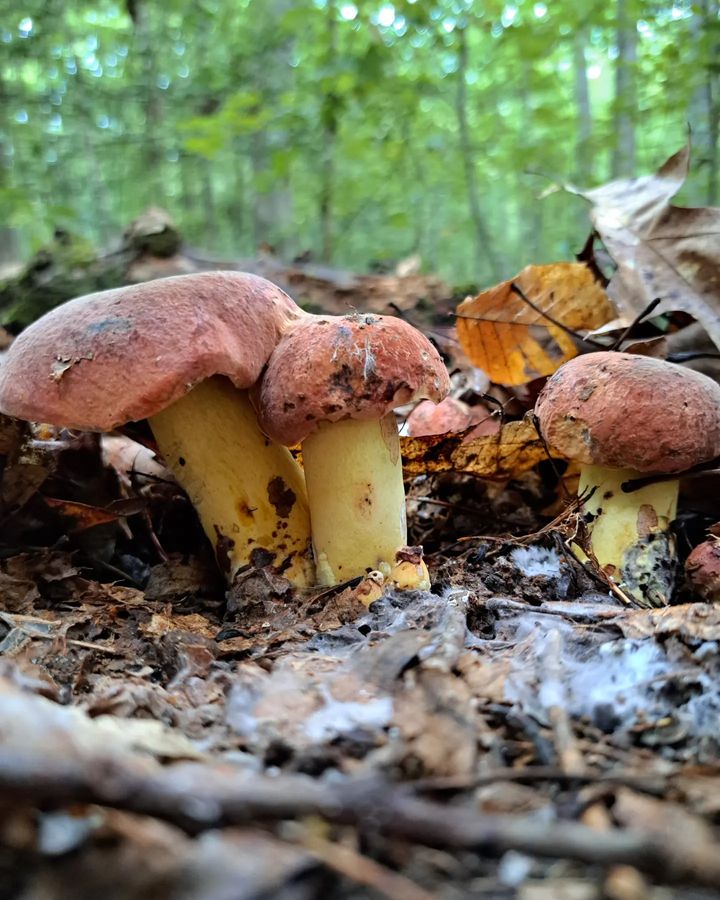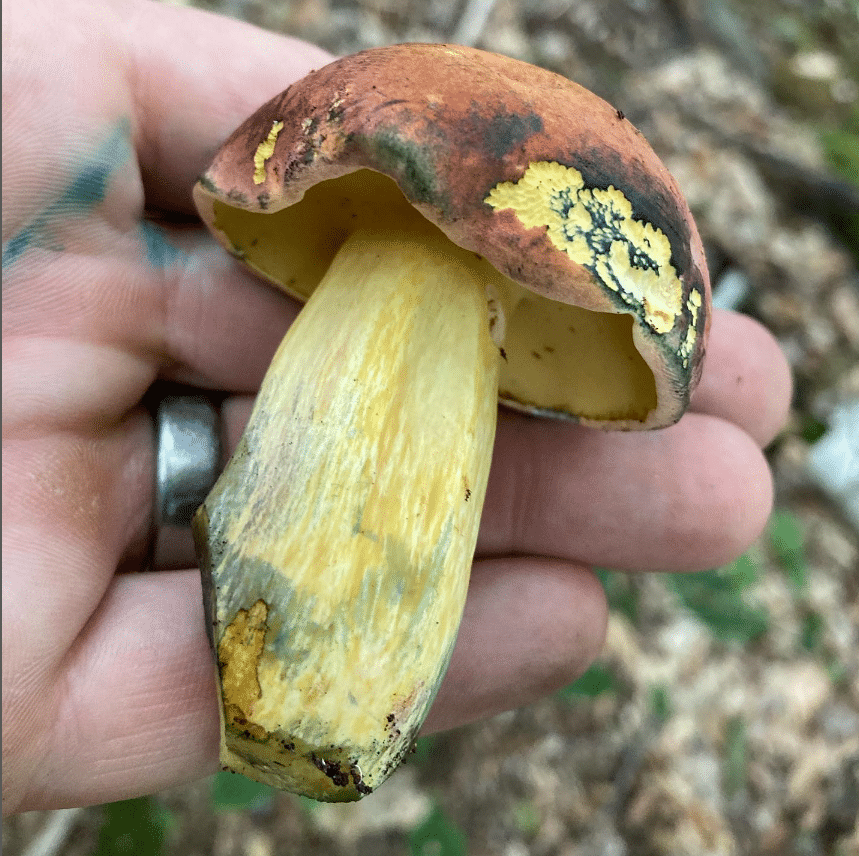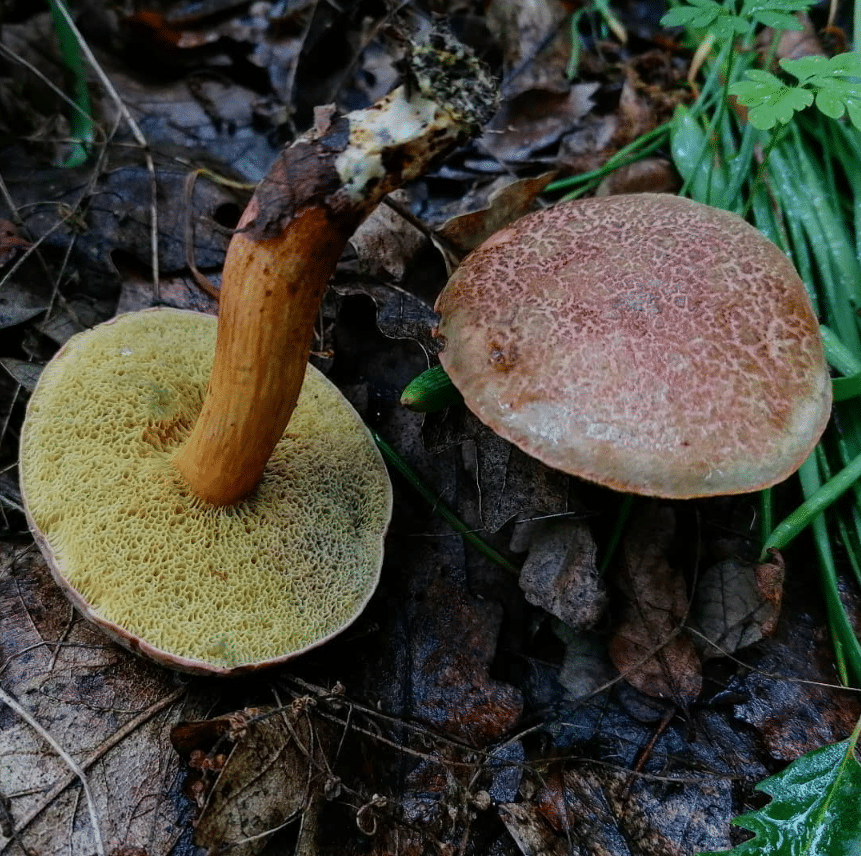You may think of using Bicolor Bolete in your exotic recipe, given its umami taste. But not every red-capped mushroom is a Bicolor Bolete, they might rather be its poisonous look alikes.
Follow along to learn in detail about the feature of the Bicolor Bolete to set them apart from its inedible look alikes.
Table of Contents Show
How Does a Bicolor Bolete Look Like?
Bicolor Bolete (Baorangia bicolor) is a medium to large-sized edible Mushroom variety prized for its unique appearance.
Further, the cap is convex flat and has a scaly texture, growing up to 6 inches wide, with a yellow center.
Following that is the 2-4 inches yellowish, cylindrical stem which holds onto the entire mushroom structure.

One of the major distinctions of the Bicolor Bolete Mushroom from its look-alikes is the sponge-like pores inside the cap instead of the gills.
Moreover, a slight bruise on the stem or flesh turns the Bicolor Bolete fainty blue to a greenish shade.
This is another important clue to correctly identify the Bicolor Bolete setting its apart from its look alikes.
Fun Fact: Bicolor Bolete has a symbiotic relationship with trees. Mushroom get nutrients from the tree, and the tree gets water and minerals from the mushroom.
3+ Poisonous Bicolor Bolete Look Alikes
One of the scariest things about mushrooms is their prolific growth and poisonous nature, especially in the wild.
You’ll come across different mushrooms, some even deceiving to look like edible ones. It is very similar to the confusion between the Shaggy Mane Mushroom and its look alikes.
Hoaxed by the appearance, you may try consuming the poisonous types and end up in a troublesome situation.
To avoid such a situation, knowing about the Bicolor and its no-edible look alikes is essential.
1. Curry Bolete
Sharing the same family, Boletacea, Boletus sensibilis is the closest look-alikes of the Bicolor Bolete.
It has a similar reddish cap resembling the Bicolor. Yellow pores and stem adds to making the differentiation difficult.

However, Boletus sensibilis has an unusual currylike smell, but Bicolor has no fragrance.
Moreover, it has the typical blue staining reaction when its flesh and pores are touched or bruised. But the bruising reaction is more pronounced than the Bicolor type.
2. Red Olive Bolete
Red Olive Bolete (Boletus miniato-olivaceus) is a type of Bolete fungus habiting mostly under hemlock trees.
One of the major distinguishing factors between the Bicolor and its fellow Boletus is the stem.
Red Olive Bolete has a yellow stem, unlike the red stalk of the Bicolor.
Despite being edible, they are not as preferred as the Bicolor for culinary use.
3. Leccium Spp.
Another on the Bicolor Bolete look alikes list is the Scaber-stalk Boletes, aka the Leccinum spp.

However, the edibility of the Leccium spp is still questionable, just like the cancer-causing Potential of the Portobello Mushroom.
Moreover, research suggests the edibility of the Leccium mainly depends upon the surrounding.
4. Red Cracking Bolete
Formerly known as Boletus chrysenteron, Red Cracking Bolete (Xerocomus chrysenteron) is a medium to small-sized mushroom.
Just like the Bicolor Bolete, they are edible and have indented shapes.

But comparing them side by side, you’ll notice the Xerocomus is a little smaller than the Bicolor with a 2-4 inch diameter. And do not have a clear dual gradient on the cap.
Also, they are not as flavorful, but you may have them by sauteing, grilling and baking.
From Editorial Team
Do Not Eat Random Wild Mushrooms!
Before you hop on to any weird internet trend about trying wild and rare mushrooms, you got to do the research.
As mushrooms may look like one but might actually be some poisonous type, we do not recommend trying them.
But if you still want to learn about them, so consult a professional or Mycologist.
